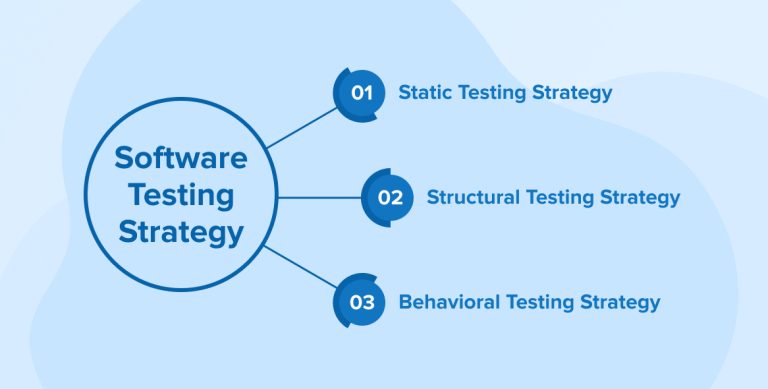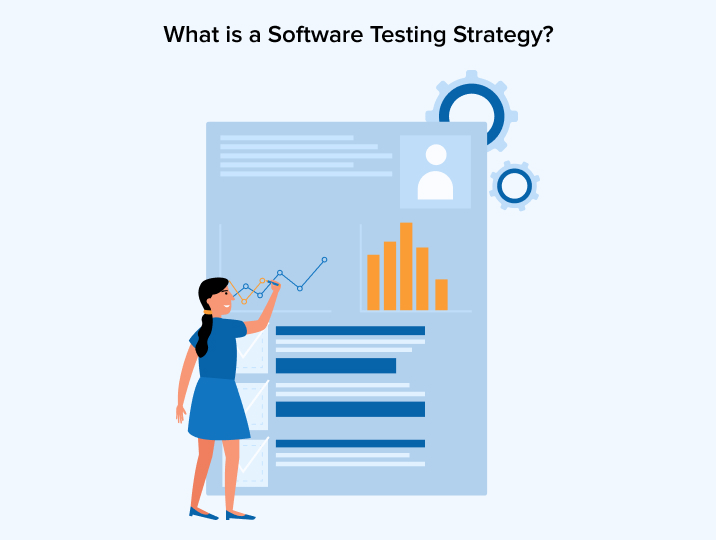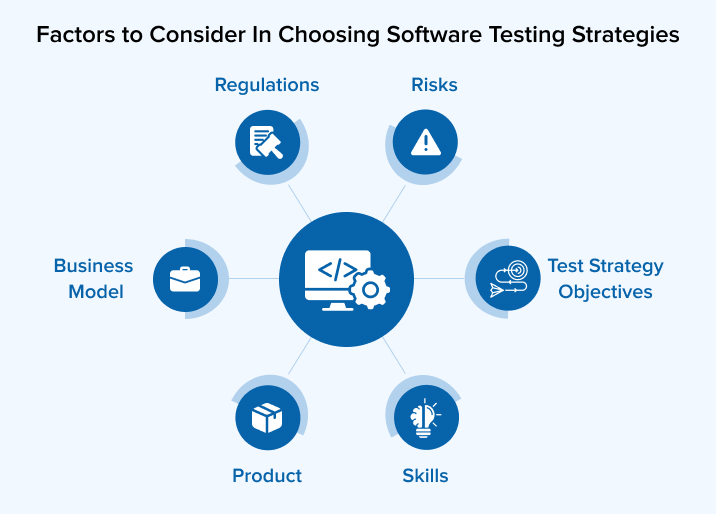Related Blogs
Table of Content
- Introduction
- What is a Software Testing Strategy?
- Software Testing Strategies
- What are the Parameters to be Considered While Writing a Test Plan?
- Effective Quality Assurance and Software Testing Strategy
- Other Effective Software Testing Strategies
- Factors to Consider In Choosing Software Testing Strategies
- Conclusion

1. Introduction
In this information age where we are driven by Software, testing of such software plays an integral part in the software development lifecycle. Not just for software quality control or assurance, this is a typical circumstance to eliminate flaws and errors. In such a situation, experts can help to enlist all the challenges faced during the development of any application. There is the best course of action and is also termed the software testing strategy. Testing strategy can create a difference by keeping in mind the best testing approach for your project. This also works in a way that helps businesses complete tasks efficiently if you want to handle this activity independently.
Let’s begin with the fundamentals and then delve deeper into the subject to determine which of the numerous test procedures and their combinations will work in your situation.
There are researches that say nearly 70% of users claim that they uninstall apps because of unsatisfactory user experience due to excessive memory usage or could be bugs interrupting the usage. So, how should you eliminate the roadblocks to good software development? But before we begin to draw attention to test plans, you must know what exactly businesses mean when they say software testing Quality Assurance.
2. What is a Software Testing Strategy?

Software Testing is a defined set of actions that must be taken to guarantee the highest level of quality for a finished product/software. This is termed as a software testing strategy. It is a set of guidelines that an internal QA department or an external QA team must adhere to in order to deliver the standard of quality you have established.
You will have to squeeze in some extra time and resources if you decide that your project doesn’t need to be flawless. The greatest way to make software engineering’s testing methodology more effective is to optimize it. A software testing plan outlines what to do, when to do it, and how to execute it in order to produce a high-quality final product.
All tiers of the technological stack must be tested as part of an effective software testing or quality assurance plan to make sure that both the individual components and the complete system function without error.
3. Software Testing Strategies
The greatest strategy to improve the efficiency of software engineering testing is to optimize the testing process. A software testing plan lays out the what, when, and how of ensuring a high-quality final result. The following software testing methodologies, or combinations thereof, are commonly employed to accomplish this overarching goal:
3.1 Static Testing Strategy
When a system’s quality is being evaluated, but not in action, a static test is being performed. Though it appears impossible at first glance, there are really several methods for doing this.
- The goal of a static test is to find issues as soon as feasible by inspecting specific parts or aspects of a system. When a developer is done developing and releasing their code, they will examine it. This sort of check is known as desk-checking, and it is performed as a type of static testing. A review meeting in which objectives, architecture, and code are examined is another type of static test.
- By catching issues with the standards before they become system bugs, static tests may be a huge time and money saver.
- If a first pass at the code reveals any problems, it will save time and effort from having to develop, deploy, and operate the system.
- With the correct resources, you can do automated static testing. There is a bug-finding tool called lint for C programmers, and a tool called JTest for Java programmers, both of which may be used to ensure that their programs adhere to a certain set of rules.
- It’s important to schedule static tests appropriately. The software testing process can benefit, for instance, from a post-development assessment of requirements, once the developers have completed the entire product’s coding.
- However, static tests contradict their own goal since testers cannot find faults in existing code without actually executing the system. In this scenario, each piece of code needs to be checked through by a developer before it can be merged into the main code base.
In fact, not just technical staff but also other stakeholders must do static testing. Objectives need to be reviewed by industry experts, designs need to be reviewed by system architects, and so on. Because of their expertise, testers’ comments are especially crucial because they may discover anomalies, omissions, hazy functioning, etc.
3.2 Structural Testing Strategy
Static tests are useful, but they are not enough. The only way to detect every software flaw is to put the code on actual hardware and run the whole system. Among the methods included in unit testing is the structural test.
- It’s also known as “white-box testing” since it’s conducted by experts in the devices and systems being tested.
- It is used to pinpoint specific problems in data flows by running tests on particular parts and interfaces.
- Use of automated, reusable test harnesses for the system under test is a prime instance. This harness enables programmers to generate structural test cases for components immediately following the coding of those components. Later, during integration, they add the tests to the main element and the repository where the code lives.
Good test harnesses double as regression test suites since they execute tests every time new code is introduced.
By using BrowserStack, you may intensify and expand your software testing methodologies, allowing you to:
- Using Selenium for Regression Testing
- Visual Regression Testing with WebdriverIO, Playwright, Cypress,
- Nightwatch Js, and TestCafe.
Developing structural tests is a job best suited for developers or very experienced testers since it requires an in-depth familiarity with the code being tested.
Developers and testers should collaborate to establish and routinely execute test harnesses. In particular, testers are valuable when it comes to creating test scripts and cases that can be used and shared by several teams.
3.3 Behavioral Testing Strategy
The goal of behavioral testing is to evaluate the actual behavior of a system rather than its theoretical workings. The processes, settings, and functionality, as well as the whole user experience, are the main emphasis. These tests, sometimes known as “black box” tests, are meant to simulate actual user interactions with a product like a website or app.
- It needs to accommodate a wide variety of users and use cases.
- Consider the system as a whole rather than its parts. This is due to the fact that only after the system has been substantially created and integrated can its behavior be evaluated from the perspective of the user.
- Some types of behavioral testing can be automated, but most are still performed manually.
- In order to find bugs during manual testing, you must meticulously plan, create, and review your results.
- Automation testing, in contrast, performs repeated operations, such as regression tests, to ensure that the introduction of new code has not compromised the functionality of previously established features. To test a website, one may fill out a form with 50 different values. This process must be performed with several different values. It’s smarter to let a computer do it instead of investing time, human labor, and making mistakes.
It is true that familiarity with the technical aspects of the system is necessary for conducting effective behavioral tests. Software testers require some understanding of the commercial context of the product, particularly with regards to the needs and expectations of the intended audience. They need to anticipate how people will interact with a website or app in order to design appropriate test cases.
4. What are the Parameters to be Considered While Writing a Test Plan?
You already know that the most essential step in the Test Management Process is to create a Test Plan. To construct a test plan, follow the seven stages outlined below.
- Examine the testing plans
- Create a test strategy
- Create a list of test objectives
- Specify the test criteria
- Organizing Resources
- Construct a Test Environment
- Estimation and Schedule
5. Effective Quality Assurance and Software Testing Strategy
Businesses would observe that it is a tiring process for businesses to ensure quality checks at each step. In the test process, you need stringent quality check steps. A planned set of organizational actions is included in the development process of software. It also acts as a component of quality management. These measures aim to enhance the software development process by setting quality standards for preventing mistakes and faults in the final output. There are ways you can strategize an effective software testing process like some of the ones, we will be discussing software testing strategies here,
5.1 Product Requirement Identification
Requirements analysis is a crucial step in determining if a system or software project will be successful. Functional and non-functional requirements are the two categories into which requirements are typically divided.
The first type of product requirement is Functional Requirements: These requirements are quite standard that enable systems to meet in order to provide the fundamental services that the end-user has requested. Functional services are the added functionalities that can be added to the product. As specified in the contract, each of these features must be included in the system.
The second type of requirement is the Non-functional requirements: These are essentially the quality requirements specified in the project contract that the system must undergo and meet. Different projects prioritize these criteria differently or apply them to different degrees.
5.2 Define the Objectives of the Software Testing Strategy
The efficiency of the software and its capacity to reach the target, any failure to meet criteria and carry out functions, and the cost of defects or errors, which refers to the expense involved in correcting the error, are a few examples of testing objectives. The test strategy needs to explicitly state each of these objectives. Testing is the process of looking into and examining a program to determine whether there are any errors and whether it complies with the requirements. There are certain goals that are expected from a software testing strategy such as;
- A good test case and successful testing are both indicated by a large number of errors that were discovered throughout the test. So, the first objective of software testing is to eliminate bugs and flaws.
- These are necessary to improve the product, support you in effortlessly integrating all the upgrades, and assist you to resolve faults that impair software usability and user experience. While selecting the appropriate testing strategy, keep this in mind.
5.3 Develop a Testing Process
Test Policy
Test Policy is a type of document created for reference at the organizational level that has the highest level of authority. It outlines both the company’s primary test objectives and the test principles that were embraced by the company. Additionally, it describes how testing will be carried out and how a business evaluates the effectiveness and success of tests.
The process of testing policy development is not standardized, although it usually involves the following:
- The test policy differs from company to company, and the definition of testing changes with it.
- With its security testing, it checks common benchmarks and requirements for software testing in projects. It also checks the definitions of test terms provided to help understand the use in other texts.
- Strategies for enhancing the testing procedures as well as measurements and methods for measuring the effectiveness of testing.
Quality management plan
When you want to develop a quality management plan, it is a document that outlines how the project will reach an acceptable level of product quality. Although it is not required, it will help you arrange all the work necessary to guarantee that the project fulfills the requirements and expectations of your client. This plan’s primary objective is to assist project managers and aid in process organization by outlining roles, responsibilities, and quality criteria that must be met. The software’s quality requirements should be included, along with information on how they should be evaluated.
When you create a strategy for quality management, ensure to include these quality management aspects like;
- Setting the right company goals
- Make sure that satisfactory quality level, key project deliverables, and processes are achieved through this process
- Actions for ensuring and controlling quality
- Roles and responsibilities of quality Assurance engineer.
Strategy Plan
The only reason behind creating a plan is to fill any missing gaps in the testing strategy. They are found and thanks to the comprehensive technical assessment that is a part of strategy planning. Therefore, technical reviewers must assess the suitability and quality of the test plan and test cases in order to raise the standard for software quality. It is always good to include some of the essential strategy plans. A test strategy’s key elements are:
- Include the testing’s parameters
- Aim for high-standard testing goals
- Budgetary restrictions
- Status updates and communication
- Evaluating metrics and measurements
- Reporting and monitoring of errors
- Industry benchmarks & Configuration
- Timeline and schedule for conducting tests
- Identifying and eliminating risks
The test strategy is a component of the test plan in a small project. However, the PM must construct a test strategy as a distinct, static document for a bigger project, from which each test plan can be further expanded.
Test Cases
Each individual test has a case attached to it. A good test strategy document can help you understand the test cases in depth, strategize the solution, plan the testing scope and then manage the test coverage with the help of testing tools. The QA team will perform different types of testing like automation testing, load testing, performance testing, behavioral testing, black box testing, beta testing, stress testing, static testing, formal testing, regression testing, unit testing, user acceptance testing or any other testing methodologies to make testing easier.
5.4 Technical Review
To conduct formal technical reviews, you can find errors that haven’t yet been found. Software testing requires significantly less time and effort when effective technical reviews are completed beforehand, which in turn minimizes the total length of time that software must be developed.
Software engineers engage in this activity to identify logical and functional flaws as they first appear. A group meeting called an FTR is when participants in certain roles check that the software being built complies with established standards and specifications.
5.5 Automated Testing
When it comes to automated testing, there are a variety of test tools available and many different test automation tools available. Both open-source and for-profit options are available. The most popular ones worth checking initially include Selenium, Katalon Studio, Unified Functional Testing, and several other options. Although it can be used in typical Agile workflows, automated testing is also a component of the DevOps approach and continuous integration practice.
5.6 Continuous Integration and Continuous Deployment
CI/CD is a popular process of software development. Developers must incorporate changes into a product on a daily basis according to the CI development practice. Every time a piece of code is changed, it undergoes “integration tests” to help in finding flaws and errors more rapidly. To make your code reliable, it’s a good idea to combine CI with automated testing.
The Agile concepts are thought to have evolved into continuous delivery (CD). With this approach, you can rapidly and sustainably introduce changes to your clients. Without requiring quick release iterations, CD enables the commitment of new code as soon as it is available. Normally, any update that passes the tests is deployed automatically. High levels of testing and deployment automation help to achieve this.
6. Other Effective Software Testing Strategies
A healthy software testing process or Quality Assurance strategy requires tests at all technology stacks and levels to ensure that every part of testing activities is validated. As well as the entire system of software testing works correctly from the perspective of developers and testers. Software testing strategies must include the following:
6.1 Allocate Time for Fixing:
As soon as the flaws are found, it’s critical to allocate time for the developers to find resolutions for the problems. The business also requires time to retest the fixes. There in the process of creating a strategy, start with allocating time for fixing.
6.2 Resolving Consistent issues First
Develop a culture that will encourage developers and testers to make changes for issues that would improve the bottom of the app. If you want to save time and effort on communication, start to build a testing strategy between them. All aspects of testing and fixing involve collaboration. Software testing and fixing are all about collaboration. Although it is important that the development team should not waste time on a wild goose chase, it is equally important that bugs are not just shuffled back and forth.
6.3 Manual Testing Process
A manual test must be exploratory since an automated test suite should be used if it is possible to write down or script any issue in precise words. The testers must detect bugs without a script because real-world use of the software won’t follow a script. A lot of test teams prefer to script manual software testing so testers follow a set of steps and work their way through a set of tasks that are predefined for software testing. This misses the point of manual testing. If something could be written down or scripted in exact terms, it could be automated and belongs in the automated suite.
Real-world use of the software testing will not be scripted, thus the team of testers must be free to probe and break things without a script.
6.4 Promote Clarity
You must write a bug report that encourages clarity rather than confusion. However, a developer must also make an effort to communicate clearly with others. Reporting bugs and asking for more information could create unnecessary overhead costs. A good bug report could save time by avoiding miscommunication or a need for more communication. In the same way, a bad bug report could lead to a fast dismissal by a developer. These could create problems. Anyone reporting bugs should make it a point to create bug reports that are informative. However, it is also integral for a developer to go out of the way to effectively communicate as well.
6.5 Periodic Testing:
Periodic tests help to avoid massive backlogs from issues that keep on accumulating and depleting the morale of developers because of the apps. The same as all other forms of software testing, manual software testing will work best when it occurs often throughout the software development process in the project, in general, weekly or bi-weekly. This helps in preventing huge backlogs of problems from building up and crushing morale. Frequent testing is considered the best approach.
Testing and fixing software could be tricky, subtle, and even political. Nevertheless, as long as one is able to anticipate and recognize common issues, things could be kept running smoothly. The ideal strategy is frequently testing.
7. Factors to Consider In Choosing Software Testing Strategies

7.1 RISKS
Risk management is paramount during testing software projects, thus considering the risks and the risk levels are of massive importance. For an app that is well-established that’s slowly evolving, regression testing is a critical risk. That is why regression-averse strategies make a lot of sense. This means it works well for apps evolving. For a new app, a risk analysis could reveal various risks if you choose a risk-based analytical strategy.
7.2 Test Strategy Objectives
The testing plans are developed with software testing objectives. Software testing should satisfy the requirements and needs of stakeholders to succeed. If the objective is to look for as many defects as possible with less up-front time and effort invested, a dynamic test strategy makes sense.
7.3 Skills
Skills are the most important factors considered while software testing. Take into consideration which skills the testers possess and which they lack. Since software testing strategies should not only be chosen but executed as well. A standard-compliant test strategy is a smart option when lacking skills and time in the team to create a testing approach.
7.4 Product
Different products have different specifications. Some products such as contract development software and weapons systems tend to have requirements that are well-specified. This could lead to synergy with an analytical test strategy that is requirements-based.
7.5 Business Models
Often business considerations and test strategies are non-matching. It is very important to align your business requirements with a software development approach. Using a legacy system as a model for a new one, everyone could use a model-based strategy.
7.6 Regulations
You must choose testing software strategies with an eye towards the factors mentioned earlier, the schedule, budget, and feature constraints of the project, and the realities of the organization and its politics. In some instances, one may not only have to satisfy stakeholders but regulators as well. In this case, one may require a methodical strategy and test types that satisfy these regulators.
8. Conclusion
To sum up, developing a software testing strategy is an ideal choice and every business must choose to develop one. To draw a software testing plan, strategy serves as a blueprint for the testing process and your units need to be tested. It enables smooth communication between managers and clients. The software testing strategy is a methodical approach and is more functionally comprehensive. It accurately estimates the timeline of work and expense of the testing process. You can now simply trust your products without any cross-validations because the software testing strategy has performed its task.

Vishal Shah
Vishal Shah has an extensive understanding of multiple application development frameworks and holds an upper hand with newer trends in order to strive and thrive in the dynamic market. He has nurtured his managerial growth in both technical and business aspects and gives his expertise through his blog posts.
Subscribe to our Newsletter
Signup for our newsletter and join 2700+ global business executives and technology experts to receive handpicked industry insights and latest news
Build your Team
Want to Hire Skilled Developers?





We know that this blog has showcased how software testing strategy is defined on the basis of types of business.According to the dynamic needs of the businesses, various testing approaches are taken up which is also very well discussed in this article.Also, the benefits of software testing like improved software product quality and providing hassle-free operations are described descriptively.
Custom software built for enterprises accelerates growth. For better growth, there should not be any glitches in the software. So, proper software testing strategies should be implemented by a software testing company for the entire software development process. I have found this article pretty useful and can be handy for software testers.